The 2008 Findhorn Dunes Trust Lichen Survey by Brian and Sandy Coppins found 130 lichens and 15 lichenicolous fungus – these are tiny fungi growing on lichens- growing on the sand, on pebbles and on heather stems at Findhorn. This number has now grown to over 200- all possible because I live locally and being a member of the Findhorn Hinterland Trust means I visit frequently and I enjoy adding to the knowledge we are building up about the land.
This also means that changes in the population can be seen. A beautiful little lichen, Placopsis, which is normally found in Highland and western Scotland on damp acid rocks was surprisingly found here, growing on 14 pebbles in a little group. Maybe a spore blew in and allowed the first one to grow, which then spread on to the other pebbles nearby. Now it has gone – the crusty lichen probably flaked off and blewaway.
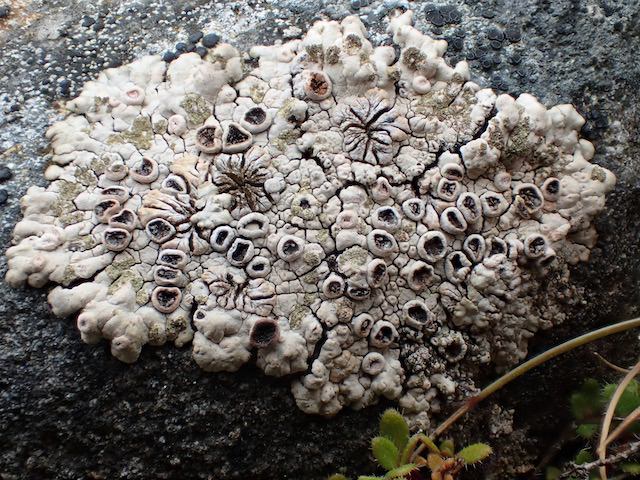
Placopsis growing on a damp rock in the Highlands. This lichen is a partnership of 3 organisms- it is a fungus that partners with a green alga and a cyanobacterium which is inside the star-shaped structures. All together they form the lichen- a mini-eco-system. The “jam tarts” contain tiny fungal spores which will be ejected and need to find new partners to grow into a new lichen. Copyright Heather Paul.
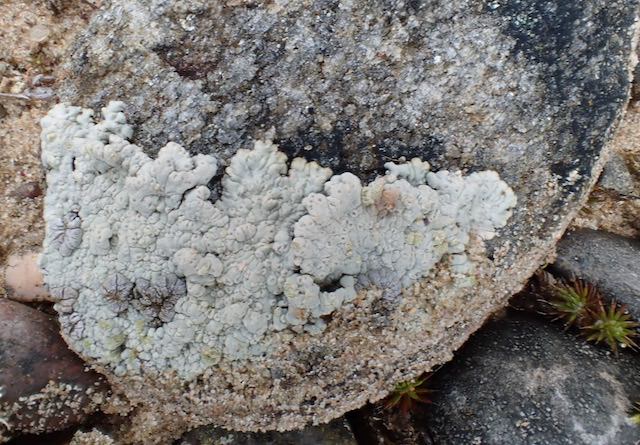
Placopsis growing on a pebble at Findhorn. This lichen is usually difficult to remove but the lichens growing at Findhorn on pebbles were not so strongly attached. Copyright Heather Paul.
On the other hand Peltigera malacea, endangered and nationally rare, continues to grow well on the sand and some beautiful P malacea that was destroyed by a motorbike going up a bank about 6 years ago has now recovered. This lichen is greeny-blue when damp but brown and curled up when it is hot and dry.
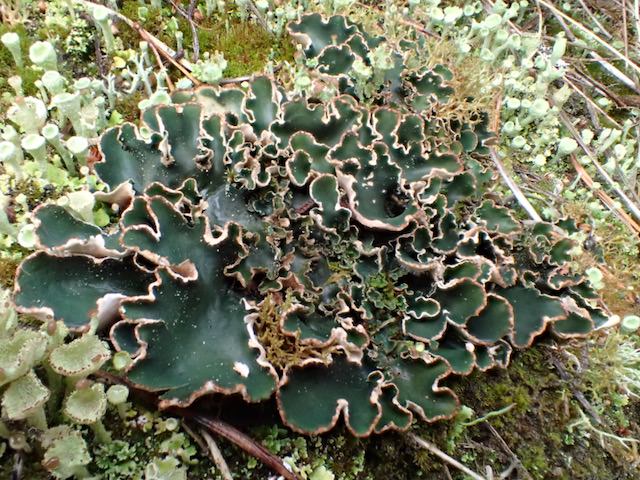
Peltigera malacea, damp after rain, surrounded by tiny Cladonia “pixie cups”. Copyright Heather Paul
In July 2023 after 15 years of looking for it, I found a small population of Cetraria islandica, a lichen that is more usually found on mountains but sometimes grows on coastal heathlands. Although not a moss, it is also called“Iceland Moss.” This lichen is important as food for caribou and reindeer and is “soaked for a few days to remove bitter acids it contains, then boiled and eaten either as a broth or jelly.“ (Frank Dobson, Lichens) An incredibly versatile addition to food, it has also been used in making bread and ship’s biscuits to help them last longer, for throat pastilles, herbal sweets and herb tea. It’s been added to luncheon meat and cream-filled pastries to reduce spoilage, and has also been used as a laxative and taken for coughs, tuberculosis and as an antibiotic! (The Vanishing Lichens, David Richardson).
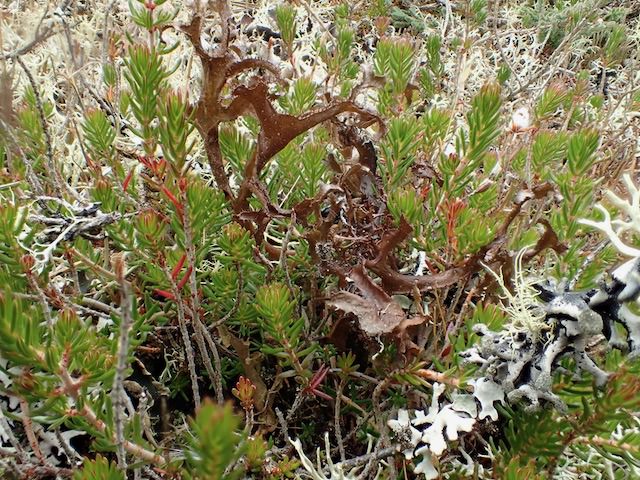
Brown Cetraria islandica (Iceland moss) growing on the coastal dune heathland at Findhorn. Copyright Heather Paul.
On the same day in July two lichenicolous fungi were found growing on Peltigera – Refractohilum peltigerae and Dacampia peltigericola. They were just microscopic black dots, difficult to see with the human eye and needed to be looked at through a microscope to see the internal structures. They were identified by Brian Coppins and are new to Great Britain and Ireland.
The photo shows the asci (sacs) which contain brown spores (reproductive parts) of Dacampia peltigericola. When these are released they can grow into another tiny fungus living on a lichen.
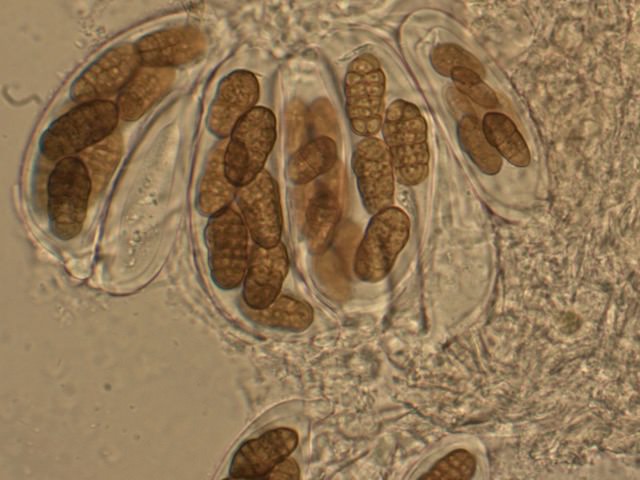
Microscope image of Dacampia peltigericola, lichenicolous fungus, growing on Peltigera malacea at Findhorn. Copyright Heather Paul.
This is all part of the rich biodiversity of the Findhorn Hinterland and part of the unseen web of life.
Aren’t we fortunate to live with such riches on our doorstep?
Heather Paul
FHT Member and Lichen Enthusiast
August 2023

















The Rich Lichen Biodiversity of the Findhorn Dunes
The 2008 Findhorn Dunes Trust Lichen Survey by Brian and Sandy Coppins found 130 lichens and 15 lichenicolous fungus – these are tiny fungi growing on lichens- growing on the sand, on pebbles and on heather stems at Findhorn. This number has now grown to over 200- all possible because I live locally and being a member of the Findhorn Hinterland Trust means I visit frequently and I enjoy adding to the knowledge we are building up about the land.
This also means that changes in the population can be seen. A beautiful little lichen, Placopsis, which is normally found in Highland and western Scotland on damp acid rocks was surprisingly found here, growing on 14 pebbles in a little group. Maybe a spore blew in and allowed the first one to grow, which then spread on to the other pebbles nearby. Now it has gone – the crusty lichen probably flaked off and blewaway.
Placopsis growing on a damp rock in the Highlands. This lichen is a partnership of 3 organisms- it is a fungus that partners with a green alga and a cyanobacterium which is inside the star-shaped structures. All together they form the lichen- a mini-eco-system. The “jam tarts” contain tiny fungal spores which will be ejected and need to find new partners to grow into a new lichen. Copyright Heather Paul.
Placopsis growing on a pebble at Findhorn. This lichen is usually difficult to remove but the lichens growing at Findhorn on pebbles were not so strongly attached. Copyright Heather Paul.
On the other hand Peltigera malacea, endangered and nationally rare, continues to grow well on the sand and some beautiful P malacea that was destroyed by a motorbike going up a bank about 6 years ago has now recovered. This lichen is greeny-blue when damp but brown and curled up when it is hot and dry.
Peltigera malacea, damp after rain, surrounded by tiny Cladonia “pixie cups”. Copyright Heather Paul
In July 2023 after 15 years of looking for it, I found a small population of Cetraria islandica, a lichen that is more usually found on mountains but sometimes grows on coastal heathlands. Although not a moss, it is also called“Iceland Moss.” This lichen is important as food for caribou and reindeer and is “soaked for a few days to remove bitter acids it contains, then boiled and eaten either as a broth or jelly.“ (Frank Dobson, Lichens) An incredibly versatile addition to food, it has also been used in making bread and ship’s biscuits to help them last longer, for throat pastilles, herbal sweets and herb tea. It’s been added to luncheon meat and cream-filled pastries to reduce spoilage, and has also been used as a laxative and taken for coughs, tuberculosis and as an antibiotic! (The Vanishing Lichens, David Richardson).
Brown Cetraria islandica (Iceland moss) growing on the coastal dune heathland at Findhorn. Copyright Heather Paul.
On the same day in July two lichenicolous fungi were found growing on Peltigera – Refractohilum peltigerae and Dacampia peltigericola. They were just microscopic black dots, difficult to see with the human eye and needed to be looked at through a microscope to see the internal structures. They were identified by Brian Coppins and are new to Great Britain and Ireland.
The photo shows the asci (sacs) which contain brown spores (reproductive parts) of Dacampia peltigericola. When these are released they can grow into another tiny fungus living on a lichen.
Microscope image of Dacampia peltigericola, lichenicolous fungus, growing on Peltigera malacea at Findhorn. Copyright Heather Paul.
This is all part of the rich biodiversity of the Findhorn Hinterland and part of the unseen web of life.
Aren’t we fortunate to live with such riches on our doorstep?
Heather Paul
FHT Member and Lichen Enthusiast
August 2023